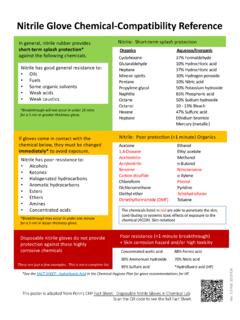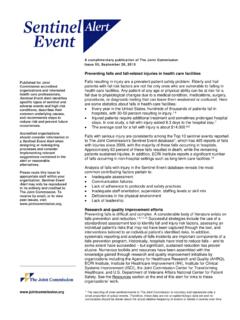Transcription of ELECTRICAL SAFETY RISK ASSESSMENT
1 ELECTRICAL SAFETY RISK ASSESSMENT The intent of this procedure is to perform a risk ASSESSMENT , which includes a review of the ELECTRICAL hazards, the associated foreseeable tasks, and the protective measures that are required in order to maintain a tolerable level of risk. A risk ASSESSMENT should be performed before work is started. Risk ASSESSMENT Steps 1. Identify the ELECTRICAL hazards associated with the task and the ELECTRICAL system, or ELECTRICAL process involved (example: shock hazard risk; arc flash hazard risk). 2. Identify the ELECTRICAL work to be performed within the ELECTRICAL system or process. 3. Define the possible failure modes that result in exposure to ELECTRICAL hazards and the potential resultant harm. 4. Assess the severity of the potential injury from the ELECTRICAL hazards.
2 5. Determine the likelihood of the occurrence for each hazard. 6. Define the level of risk for the associated hazard. 7. If the level of risk is not acceptable, identify the additional measures or corrective actions to be taken. Example: wear appropriate PPE and if the risk too great, do not perform the task. The risk related to an identified hazard may be thought of as being composed of the severity of the injury and the likelihood of occurrence of that injury. Figure 1 Elements of Risk Risk ASSESSMENT Calculation Following are two examples of methods that can be used to conduct ELECTRICAL risk assessments. In the first, The Risk Register Method, the risk is derived using the risk parameters as shown in Figure 1. In the second, the risk is derived from using a Risk ASSESSMENT Matrix as shown in Figure 2.
3 Risk Register Method: 1. Severity of the Possible Injury or Damage to Health (Se) Severity of injuries or damage to health can be estimated by taking into account reversible injuries , irreversible injuries , and death. Typically, the types of hazards to be considered include, but are not limited to, shock and electrocution, burns, and impact. Choose the appropriate Severity value from Table 1 below. Add value to the Risk Register (Table 5) Severity of Injury of Damage to Health Se Value Irreversible trauma, death. 8 Permanent skeletal damage, blindness, hearing loss, third degree burns. 6 Reversible minor impact, hearing damage, second degree burns. 3 Reversible minor laceration, bruises, first degree burns. 1 Table 1 2. Frequency and Duration of Exposure (Fr) - The following aspects should be considered to determine the level of exposure: a.
4 Need for access to the hazard zone based on all modes of use; for example, normal operation and maintenance b. Nature of access, for example, examination, repair, and troubleshooting. Choose the appropriate Frequency value from Table 2 below. Add value to the Risk Register (Table 5) Frequency of Exposure Fr Value (for Duration > 10 min) < 1 per hour 5 > 1 per hour to < 1 per day 5 > 1 per day to < 1 every 2 weeks 4 > 1 every 2 weeks to < 1 per year 3 > 1 per year 2 Table 2 3. Likelihood of Occurrence of a Hazardous Event (Pr) The occurrence of a hazardous event influences the likelihood of the occurrence of injury or damage to health. The possibility of the hazardous occurring should describe the likelihood of the event materializing during the use or foreseeable misuse, or both, of the ELECTRICAL system or process.
5 Subjectivity may have a substantial impact on the result of the risk ASSESSMENT . The use of subjective information should be minimized as far as reasonably practicable. The likelihood of occurrence of the hazardous event should be estimated independently of other related parameters (Fr and Av) and will typically be based on the results of the completed study of the arc flash potential. The worst-case scenario should be used for this parameter to ensure that short-circuit interruption device(s) have, where practicable, been properly selected and installed and will provide adequate protection. Elements of the ELECTRICAL system that are intended to ensure an intrinsically safe design shall be taken into consideration in the determination of the likelihood of the hazardous event(s).
6 These can include, but are not limited to, the mechanical structure, ELECTRICAL devices, and electronic controls integral to the system, the process, or both at the time of the analysis. Types of components that could contribute to an inherently safe design include, but are not limited to, current-limiting devices and ground-fault circuit interrupters. This parameter can be estimated by taking into account the following factors: a. The predictability of the performance of component parts of the ELECTRICAL system relevant to the hazard in different modes of use ( , normal operation, maintenance, fault finding). At this point in the risk ASSESSMENT process, the protective effect of any personal protective equipment (PPE) and other protective measures should not be taken into account.
7 This is necessary in order to estimate the amount of risk that will be present if the PPE and other protective measures are not in place at the time of the exposure. In general terms, it must be considered whether the ELECTRICAL system being assessed has the propensity to act in an unexpected manner. The ELECTRICAL system performance will vary from very predictable to not predictable. Unexpected events cannot be discounted until it can be clearly demonstrated that the ELECTRICAL system will perform as expected. b. The specified or foreseeable characteristics of human behavior with regard to interaction with the component parts for the machine relevant to the hazard, which can be characterized by one or both of the following: i. Stress ( , due to time constraints, work task, perceived damage limitation).
8 Ii. Lack of awareness of information relevant to the hazard. Human behavior will be influenced by factors such as skills, training, experience, and complexity of the machine or the process. These attributes are not usually directly under the influence of the ELECTRICAL system designer, but a task analysis will reveal activities in which total awareness of all issues, including unexpected outcomes, cannot be reasonably assumed. Very high likelihood of occurrence of a hazardous event should be selected to reflect normal workplace constraints and worst-case considerations. Positive reasons ( , well-defined application and a high level of user competence are required for any lower values to be used. Any required or assumed skills, knowledge, and so forth, should be stated in the information for use.)
9 Select the appropriate value for Likelihood of Occurrence of Hazardous Event (Pr) from Table 3 below. Add value to the Risk Register (Table 5). Likelihood of a Hazardous Event Pr Value Very high 5 Likely 4 Possible 3 Rare 2 Negligible 1 Table 3 Listed below are examples of general questions to consider in determining the likelihood of an event (risk): Has the equipment been installed in accordance with NFPA 70 , National ELECTRICAL Code (NEC )? Has the equipment been maintained and tested in accordance with the manufacturer s instructions? How old is the equipment? Is there any visual indication of overheating? Is any component, device, or equipment loose or damaged? The following are enclosure questions: Do all enclosure doors operate and latch properly?
10 Does the enclosure have all of its bolts and screws installed? Does the equipment or enclosure have ventilation openings? Is the enclosure arc rated? Are there openings in the enclosure that rodents or other vermin could enter? Is there an indication of moisture in the equipment? Has the enclosure been examined for dust, dirt, soot, or grease? Is there any indication of overheating of the bus work, etc., in the enclosure, such as discoloration? The following are circuit breaker (CB) condition questions: Has the CB periodically been operated in accordance with the manufacturer s instructions? Has the CB been applied within its marked rating? Has the right type of CB been used? Have the proper conductor types and sizes been used to connect to the CB?



